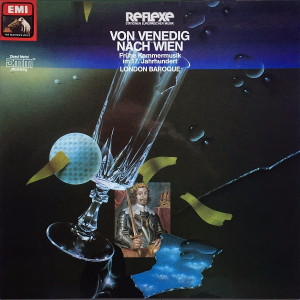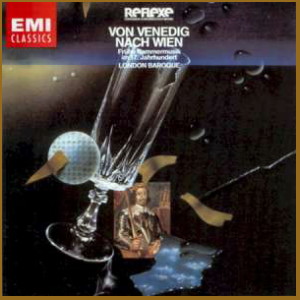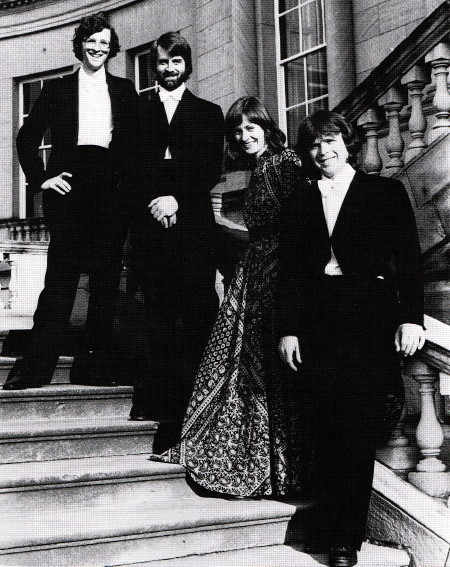 |
1 LP -
1C 069-1466961 - (p) 1983
|

|
| 1 CD - 8
26534 2 - (c) 2000 |
 |
| 1 CD -
CDM 7 63147 2 - (c) 1989 |
|
| VON VENEDIG NACH WIEN - Frühe
Kammermusik im 17. Jahrhundert |
|
|
|
|
|
| Dario Castello (1. Hälfte d.
17. Jh.) |
|
|
| -
Sonata quarta a 2 (aus "Libro
primo Sonate concertate", Venezia
1658) - Violine, Viola da gamba,
Orgel |
4' 21" |
|
| - Sonata
seconda a soprano solo (aus
"Libro secondo", Venezia 1644) - Violine,
Cembalo |
4' 47" |
|
Girolamo Frescobaldi
(1583-1643)
|
|
|
| - Toccata
decima (aus "Secondo Libro
di Toccate", Roma 1637) - Cembalo |
4' 15" |
|
| - Canzon terza
(aus "Secondo Libro di Toccate",
Roma 1637) - Orgel |
5' 09" |
|
| - Canzon
quinta a basso solo detta la
Tromboncina (aus "Il Primo
Libro delle Canzoni", Roma 1628) -
Viola da gamba, Cembalo |
4' 36" |
|
| Heinrich Ignaz Franz Biber
(1644-1704) |
|
|
- Sonata IV
(aus "Sonatae a violino solo",
Salzburg 1681) - Violine,
Orgel
|
11' 41" |
|
|
|
|
| Johann Heinrich Schmelzer
(1623-1680) |
|
|
| -
Sonata terza (aus "Sonatae
Unarium Fidium", Nürnberg 1644) - Violine,
Viola da gamba, Cembalo |
6' 48" |
|
| Johann Jakob
Froberger (1616-1667) |
|
|
| - Toccata 2
(Mainz 1699) - Cembalo |
3' 51" |
|
| - Canzon 2
(aus "Libro secondo di toccate,
fantasie... gigue et altre
partite", Wien 1649) - Orgel |
4' 36" |
|
| Bartolomé de Selma y
Salaverde (1570/80-1638) |
|
|
| - Canzon a 2
Tenori (aus "Primo Libro
Canzoni", Venezia 1638) - 2
Viole da gamba, Orgel |
4' 34" |
|
| Johann Nicolai (1629-1685) |
|
|
| - Sonata a 2
Viol d Gamb: et basso contonuo
(aus "Manuskript Durham.D.IO.") -
2 Viole da gamba, Orgel |
3' 53" |
|
| Johann Heinrich Schmelzer
(1623-1680) |
|
|
- Sonata a 2
(aus "Manuskript BL Add ms 31423")
- Violine, Viola da gamba,
Orgel
|
5' 14" |
|
|
|
|
| LONDON BAROQUE |
|
| -
Ingrid Seifert, Barockvioline
(Anonymus, München ca. 1670) |
|
-
Charles Medlam, Viola da gamba
(Barak Norman, London 1718)
|
|
| -
William Hunt, Viola da gamba
(Anonymus, engl. ca. 1670) |
|
-
John Toll, Cembalo un Orgel
|
|
|
|
| Cembalo:
Bill Dow, 1978 nach italienischem
Vorbild an Italian model. |
|
| Orgel:
Justin Sillman, 1982 nach einer
englischen Kammerorgel del 17.
Jh.. |
|
|
|
|
|
Luogo
e data di registrazione |
|
Temple
Church, London (Inghilterra) -
8-10 giugno 1982 |
|
|
Registrazione: live /
studio |
|
studio |
|
|
Producer / Engineer |
|
Gerd
Berg / Neville Boyling / Mark
Vigars
|
|
|
Prima Edizione LP |
|
EMI
Electrola "Reflexe" - 1C
069-1466961 - (1 lp) - durata 64'
59" - (p) 1983 - DMM (Analogico) |
|
|
Prima Edizione CD |
|
EMI
"Classics" - CDM 7 63147 2 - (1
cd) - durata 64' 59" - (c) 1989 -
ADD |
|
|
Edizione CD |
|
EMI
"Classics" - 8 26534 2 - (1 cd) -
durata 64' 57" - (c) 2000 - ADD |
|
|
Note |
|
- |
|
|
|
|
|
 FROM
VENICE TO VIENNA FROM
VENICE TO VIENNA
Early chamber music of the
17th century
Very little is known about the
life of the Venetian composer
Dario Castello. The title of
his first collection of
instrumental works describes
him as “Già
Capo di Compagnia de Musichi
d’instrumenti da fiato in
Venetia” (head of the players
at St Mark’s) whereas his
second book of pieces has
“Musico Della Serenissima
Signoria di Venetia In S.
Marco, & capo di Compagnia
de lnstrumenti” (head of the
instrumentalists). His first
book contains 12 sonatas in
two and three parts. Some are
for two treble instruments and
bass, some for treble, tenor
and bass, and others for two
violins and “fagotto”. The
second book is more
enterprising and contains two
sonatas for treble and bass, a
number for larger forces, in
which pairs of violins or
cornetti are set against
trombones or other strings,
and two sonatas in four parts
specifically for string
ensemble. The treble
instrument for parts labelled
“soprano” could be violin,
cornetto or recorder according
to the lie of the part. The
middle part is usually
labelled “trombon overo viola”
and can be played on an alto
or tenor trombone, or a tenor
or bass string instrument such
as the viol or an early form
of cello. Similarly, the bass
part can be played either on a
string bass or the dulcian, an
early form of bassoon which
was the most prominent solo
bass instrument of Castello's
Venice. The bass trombone is
an unlikely choice since many
of the parts are extremely
virtuoso. Castello’s writing
for each instrument is
perfectly idiomatic and we can
only speculate which
instrument or instruments he
played himself. The Sonata
quarta from Castello's
first book is a typical
Venetian sonata of the period:
it alternates between fugal
and homophonic textures and
triple and duple time, and
includes solo passages for
each instrument. The lower
part is only intermittently
independent of the bass line,
so that the texture varies
between two and three real
parts. The Sonata seconda
from his second book seems
to have been composed more
with the violin in mind: it
goes below the range of the
cornetto and soprano recorder,
exploits the whole musical and
emotional range of the violin
and makes use of violinistic
arpeggio figuration. The
sonata alternates between the
old polyphonic style and the
new monodic vocabulary, where
rhapsodic passages are
“invented” over held chords. In
addition, some
eastern-flavoured
ornamentation towards the very
end of the sonata as passages
make this perhaps the most
finely balanced piece in
Castello's
output and one of the most
formally satisfying in all the
classical period of Venetian
instrumental music.
Girolamo Frescobaldi was born
in Ferrara in 1583. At that
time Ferrara was one of the
most important cultural
centres of Italy
and its duke, Alfonso II d`Este,
was a keen musician (he is
reported to have liked between
two and four hours of music a
day at court). Frescobaldi
studied with the court
organist Luzzaschi and was
presumbaly influenced in one
way or another by the arrival
in 1594 of the mannerist
madrigal composer Gesualdo,
whose chromatic style pushed
the prevailing harmonic
language to its absolute
limit. Unfortunately the
d’Este court was disbanded in
1597 because of the lack of an
heir and the once brilliant
circle was dispersed. By at
least 1604 Frescobaldi was in
Rome, where he became a member
of the Accademia di S Cecilia
and subsequently organist at
St Peter’s. Here he enjoyed
the patronage of the
artistically influential and
enormously wealthy Cardinal Aldobrandini.
In 1607
Frescobaldi spent ten months
in Brussels with another
patron, Guido Bentevoglio, who
had been appointed Papal
Nuncio there and took
Frescobaldi with him in his
entourage. Here he would
definitely have met the
English keyboard virtuoso
Peter Philips and also
possibly Sweelinck, who was at
Amsterdam. After an
exasperating three months of
negotiations with the Gonzagas
at Mantua - the same
administrative difficulties
that Monteverdi encountered - Frescobaldi
moved to Florence, where he
was court organist until in
1634 he moved back to Rome,
where he died some nine years
later. He seems to have been a
rather rough and somewhat
irregular personality: he was
hardly able, if one report is
to be believed, to write his
own name and appeared to have
married as a result of a
bastard son.
His second book of toccatas
and canzonas (Il
secondo libro di toccate,
canzone, versi d’hinni,
Magnificat, gagliarde,
correnti et altri partite
d’intavolatura di cimbalo et
organo) was published in
1637 in Rome. In addition to
all the things mentioned on
the title page it contains an
interesting example of the old
technique of setting a
wellknown song as a keyboard
piece with the parts
embellished, something he must
have learned from his teacher
Luzzaschi. Frescobaldi's
toccatas feature the closest
possible juxtaposition of
contrasting elements in an
improvisatory style in which
material is seldom repeated or
used again. His source of
inspiration seems to have been
much the same as that of the
“tenebristi”, a school of
painters originating with
Caravaggio and the Caracci
brothers and their striking
“chiaroscuro” technique. His
canzonas are rather stricter,
with fewer free passages
between the contrapuntal
sections and the themes often
telescoped towards the end for
extra intensity.
Probably one of the greatest
violin virtuosos of all time
was Heinrich Ignaz
Franz Biber. Born in
Wartenberg near Reichenberg
(now Liberec) in Bohemia, he
soon entered the service of
Prince-Bishop Karl, Count
Liechtenstein-Kastelkorn of
Olomouc at Kromĕříž
(Kremsier) in central Moravia.
This was one of the most
important centres of
instrumental music in the
German-speaking world and the
library at the monastery still
holds most of the known
manuscripts of Biber’s
compositions. In
about 1670 he moved to
Salzburg, where his duties
were to provide both sacred
and secular compositions for
the archbishop. The exact
circumstances of Biber’s
departure from Kromĕříž
are not known; but Prince
Karl, in a letter to Schmelzer
in Vienna about new players
for his orchestra at Olomouc,
writes, “Biber, the fellow who
slipped away, played the
violin, bass and viola da
gamba: he also composed
tolerably well”. His first
appointment at Salzburg was as
trainer of the choirboys, from
which he was promoted to
second and eventually (in
1684) first Kapellmeister. His
output comprises several
collections for all sorts of
wind and string instruments,
the most unusual being those
for his own instrument, the
violin. His first (undated)
collection consists of 16
programmatic sonatas, each
illustrating an event from the
scriptures. All of these have
a different tuning for the
violin, known as “scordatura",
a device which Biber often
used to extend the sonority
and chordal possibilities of
the instrument. The sonatas
also use every conceivable
bowing refinement: ricochet
arpeggiation, flying staccato
in both directions, tremolos
and unusual pairings and
slurrings. The pieces of his
1681 set are mostly in the
normal tuning and are
generally longer and more
virtuoso. The fourth sonata
from this set consists of a
slow-fast prelude, a gigue
with two variations, a
rhapsodic “gypsy” section in
the minor and an aria with
four variations which
concludes with a long dominant
pedal over which the violin
plays with a number of
suitably bizarre motives.
The other great violinist of
the German-speaking world in
the 17th century was Johann
Heinrich Schmelzer. In
contrast to Biber, Schmelzer
seldom uses any other than the
normal tuning of the violin
(only one instance is known)
and only rarely calls for
double stops. Born some time
in the early 1620s the son of
a baker in Scheibbs in Lower
Austria, he was already
playing in the Hofkapelle in
Vienna while still in his
teens. He was not however
formally appointed as a
violinist in the court
orchestra until 1649. He seems
to have spent his whole life
at the Viennese court,
composing chamber and ballet
music for court productions
and even helping Emperor
Leopold I with his
compositions. His collection
of violin sonatas, Sonatae
Unarum Fidium
(Nuremberg, 1644), was the
first outside Italy
for violin and basso continuo.
The third sonata in G minor is
a set of variations on the
bass of the first ten bars -
the melody could be a popular
song of the time or
Schmelzer’s own - and contains
one of his few passages in
double stops. Like Biber he
exploits the full upper range
of the instrument, going up as
far as an octave and a third
above the open E string. His
manuscript sonata in D minor
shows many of the same
characteristics as the Sonata
a due by Castello.
Similar in form and dialogue
between the instruments, the
piece has a richer harmonic
language and a later and more
Germanic feel about it, and
the lower string instrument's part
shows a greater emancipation
from the bass line.
Johann Jakob Froberger came
from a family of Halle
musicians but was born in
Stuttgart, where his father
and elder brother were
employed in the court
orchestra. By 1634 he was in
Vienna, where he aroused the
interest of Ferdinand III,
who financed a period of study
with Frescobaldi in Rome. He
was in Vienna again between
1653 and 1658, having made
various journeys in the
meantime. He spent some time
in Paris, where he came into
contact with Chambonnières,
Louis Couperin and the
lutenist Gaultier. His journey
to London was less fortunate.
It
appears that he was robbed on
the boat to Dover and as
result had to find employment
as an organblower, a
circumstance which was
beneficial for posterity at
least, as he wrote an
exceptionally powerful
allemande to document the
experience. A further period
of study with Carissimi is
mentioned, but sadly virtually
no vocal compositions nor any
for any instrument except the
keyboard have come down to us.
Froberger must have been one
of the most cosmopolitan
musicians of his age: he
excelled in all the available
forms and styles of his time.
He is perhaps the first
composer in the history of
western music to define
tonality with total precision.
Froberger spent his last years
in the service of Sibylla of Württemberg-Montbéliard
at Héricourt
in France, where he died in
1667. His toccatas and
canzonas reproduce the form
and spirit of those of his
teacher Frescobaldi but show
an additional organisation and
classicism which stems from
his advanced tonal vocabulary
and resulting harmonic
perspective.
Fra Bartolomé
de Selma y Salaverde was an
Augustinian friar of Spanish
origin who worked in Italy
but was also employed by Karl
Ferdinand of Austria and the
Archduke Leopold, who employed
him in Innsbruck between 1628
and 1630. He appears to have
been a virtuoso dulcian
player, to judge by the
prefatory sonnet by a fellow
padre in his collection of Canzoni,
fantasie et correnti,
which describes him as the Orpheus
of the bassoon, and some of
his canzonas are variations
for dulcian on popular
songs. His sonata for two
tenor instruments is the
only one of its kind in the
collection.
Johann Michael Nicolai
appears to have been greatly
respected in his own time.
He published three
collections of instrumental
music, and the wide
dispersal of manuscripts
containing his works
testifies to the great
interest shown in his
compositions and more
specifically in those for
unusual combinations, such
as two and three bass viols.
His A minor Sonata for two
bass viols and continuo was
probably conceived as the
first movement of a dance
suite and comes from an
important collection of bass
viol pieces from all
countries and in all
combinations in the library
at Durham Cathedral. Nicolai
was born near Weimar about
1629 and after a period in
the service of the Duke of
Saxe-Lauenburg
moved to Stuttgart, where he
spent the rest of his life
as a member of the court
orchestra.
Charles
Medlam, 1983
|
|
|
EMI Electrola
"Reflexe"
|
|
|
|

